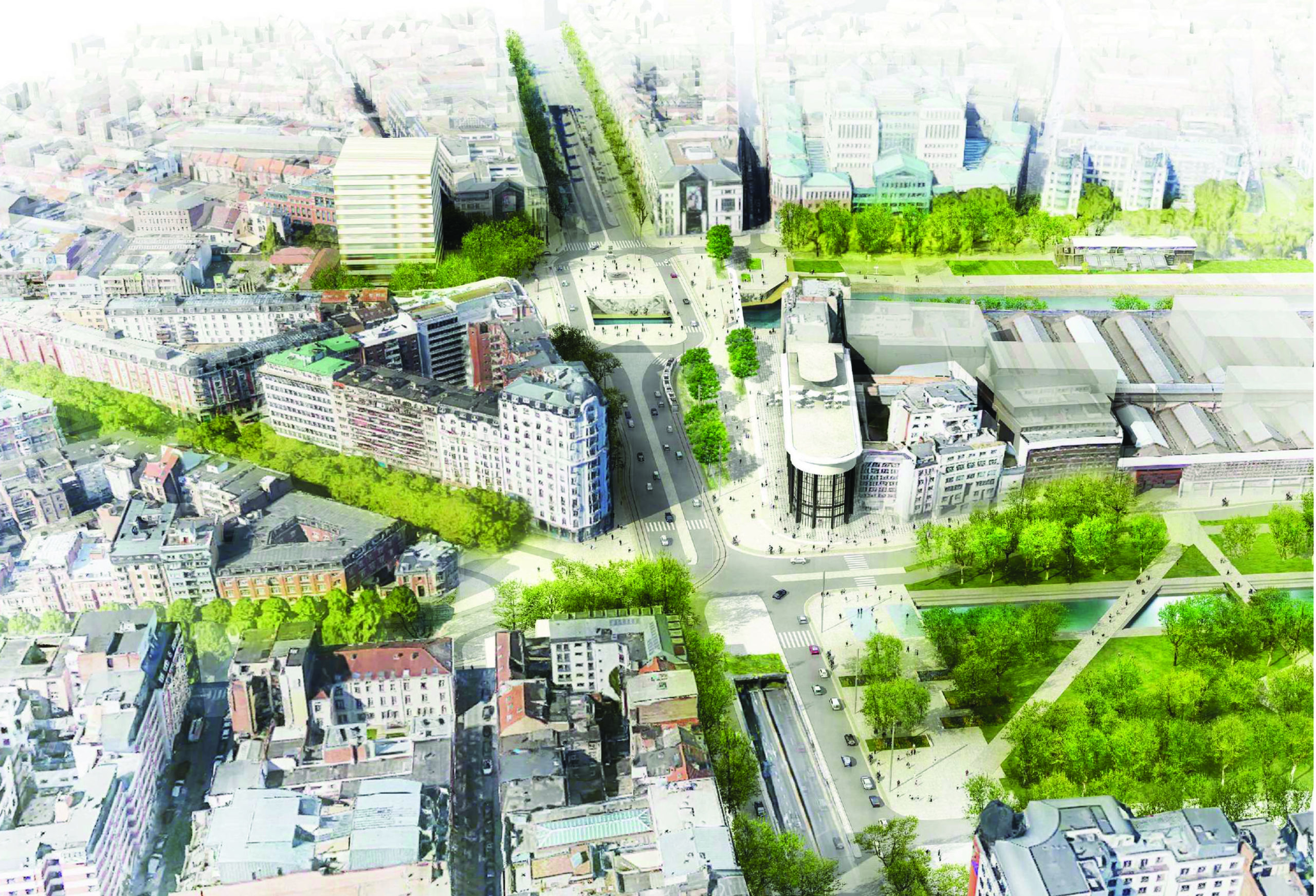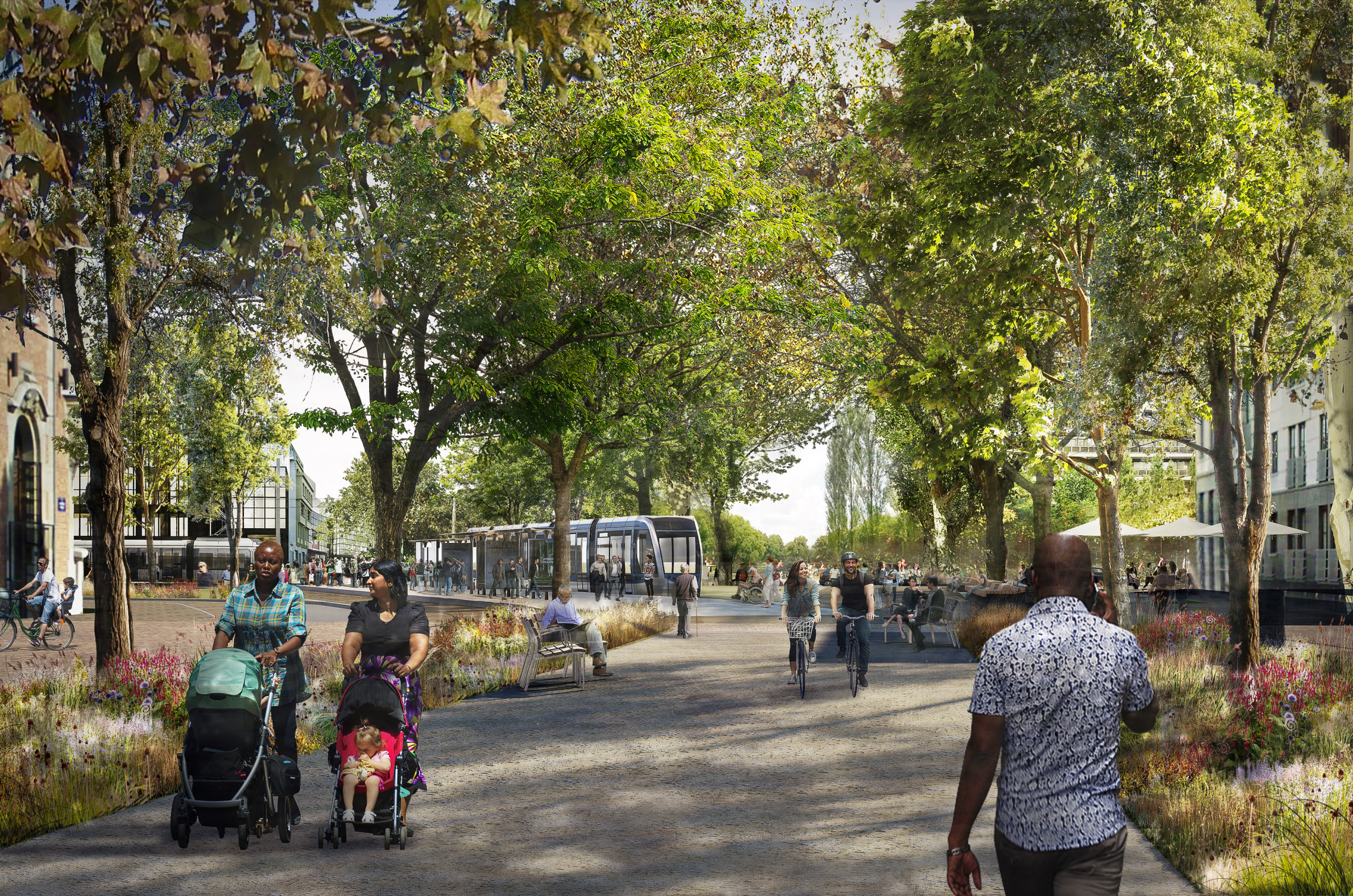Planning permit for redevelopment Sainctelette
Pedestrians and cyclists become king and queen. KANAL - Centre Pompidou receives a real forecourt with lots of trees and the bridge over the canal becomes a “bridge square”, a place where people can engage with each other and that connects both canal banks.
Pedestrians and cyclists become king and queen. KANAL - Centre Pompidou receives a real forecourt with lots of trees and the bridge over the canal becomes a “bridge square”, a place where people can engage with each other and that connects both canal banks.
“Exploiting Brussels’ great potential is the reason why I am into politics in this city. Anyone walking or cycling on Place Sainctelette today wants to leave it as soon as possible, but still you feel the potential, you see the inspiring architecture, the perspective of the canal and the new museum of contemporary art coming soon. Turning this part of the city into a beautiful piece of Brussels tailored for people was my objective when I started this major project in 2017 and I am therefore really happy and proud that we can now start the redevelopment!” said Brussels State Secretary for Urbanism Pascal Smet.
In 2017 besliste Pascal Smet, toen bevoegd voor mobiliteit en openbare werken, om hier definitief komaf mee te maken door een internationale architectuurwedstrijd uit te schrijven om de zone volledig heraan te leggen. Doelstelling? Kwalitatieve publieke ruimte aanleggen op mensenmaat.
Een jury van experten selecteerde het project van de Franse landschapsarchitecten Agence Ter, in samenwerking met het Brusselse architectenbureau Karbon en studiebureau Arcadis dat de kanaaloevers opnieuw met elkaar verbindt door een ‘brugplein’ met veel plaats voor voetgangers, fietsers en openbaar vervoer.
Door de plaats voor het autoverkeer te verminderen en te verschuiven ontstaat er veel ruimte voor aangename ontmoetingspleintjes, voor veel extra bomen en voor een echt voorplein voor het toekomstige museum KANAL – Centre Pompidou dat momenteel wordt ontwikkeld.
Current Minister for Mobility and Public Works Elke Van den Brandt and State Secretary for Urban Development Pascal Smet and their departments Brussels Mobility and urban.brussels continued to work together to optimise and concretise the plans. This process has been finalised today with the delivery of the planning permit.
"Sainctelette is one of the most notorious intersections in Brussels. And we are finally going to change that. The square will be much safer, more accessible and smoother. There will be an underpass for cyclists, several pedestrian zones and lots of green areas. By tackling this dangerous intersection, we are taking another step towards a city where everyone feels safe and at home,” said Minister of Mobility, Public Works and Road Safety Elke Van den Brandt.
“This redevelopment is also great news for the Northd district and KANAL - Centre Pompidou, which is coming soon. Many Brusselers and visitors will enjoy our city even more and appreciate this hotspot in complete safety,” said Brussels Minister-President Rudi Vervoort.
Pedestrians and cyclists become king and queen
This project fits entirely within the philosophy of the Brussels Region of giving back the space to pedestrians and cyclists and of improving the public transport flow. The design redefines the car lanes and their width. The priority is to keep traffic out of the neighbourhoods. The traffic flow between Quai du Commerce and Boulevard de Dixmude will be simplified because it won’t be possible any more to turn off from Boulevard de Dixmude towards Place de l'Yser. This will make it possible to build a real tram station between Parc Maximilien, metro station Yser and the promenade on Boulevard de Dixmude.
For pedestrians, there will be large walking areas and crossings with coordinated traffic lights. The comfort and safety of cyclists are also a central part of this project. There will be ochre separate cycle lanes in the entire area and crossings with coordinated traffic lights. These safe cycle lanes will connect to the network of separate cycle paths all along the small ring and will cross the new connection for pedestrians and cyclists under the Sainctelette bridge. Both projects obtained a planning permit.
Urban squares and many trees
The eye-catcher of the project is the creation of a “bridge square” in a place that today is only focused on car traffic. This square will be a shared space connecting the two canal banks by using homogenous materials, modern urban furniture, new lighting and trees. A minimum of height differences in the zone ensures the coherence of the new square.
Concretely, the existing bridges will be preserved. For the construction of the bridge square, the available space for pedestrians and cyclists will be increased by widening the outer sides of the existing bridges thanks to the addition of two (light) pedestrian bridges. By extending the square and connecting it to the facades, two new spaces are created. The four statues on the bridge will no longer mark its contours but will indicate the central position of the bridge square and will emphasize how big the bridge really is.
Voor de nieuwe voetgangersbruggen naast de twee bestaande bruggen worden dezelfde materialen gebruikt om het gevoel te creëren dat het plein het kanaal overspant. Op die manier zal de brug niet langer een flessenhals voor voetgangers en fietsers zijn, maar een stedelijk balkon of een ontmoetingsplaats.
In het totaal worden in het project 124 bomen voorzien.
The squares
Three areas will each have their own identity:
1. 1. The squares along the canal
On the west side of the canal (Molenbeek), the bridge square branches into several small squares. On the side of Quai des Charbonnages, new housing, offices and the activities of the future Dockside building will bring life to a small square with greenery. It will be possible to install pavement cafes and it can become a place to relax a bit. This square will be part of the green promenade connecting Molenbeek to the other canal bank.
On the other side, the axis Avenue du Port will be repositioned in order to enlarge the squares along the canal. The small central square descends towards the water and thus becomes a new balcony at the water. The monument of the canal builders stays at its current location. The small square at Quai des Matériaux offers a lovely panoramic view of the port, Quai Béco and the new Kanal facade. The slight slope invites to descend to the park. The project integrates the future cyclists passage under the bridge.
2. Urban forecourt
The space of the Sainctelette square will be redesigned in order to highlight the surrounding buildings and create a qualitative place where people can meet. The unused median strip will be narrowed down in order to create space on the lateral zones, which will be enlarged and which will be able to host activities of Kanal and the Kaaitheater.
Concretely, a wide forecourt will be created in front of the iconic facades of Kanal and the Kaaitheater. The floor covering will connect the interior of Kanal with the exterior. The floor motif will extend along the facades between Quai des Péniches and Parc Maximilien. The forecourt will become a real promenade that meets the daily needs of the neighbourhood and that will be able to host various activities. The small square will retain an open perspective towards its surrounding neighbourhoods. The open space, the urban furniture, the new lighting and homogenous materials will ensure an inviting square with an open perspective towards the surrounding neighbourhoods and suitable for all kinds of activities.
3. Place de l’Yser
Place de l’Yser will have a new look thanks to the extension of the promenade with trees on Quai du Commerce and the forecourt of Parc Maximilien.
On the side of Parc Maximilien, the redevelopment of Place de l’Yser will free up a lot of space between Boulevard Baudouin and Boulevard d'Anvers. The promenade will be extended to Parc Maximilien and the crossing will be made easier and safer. The forecourt of Parc Maximilien will have a new look and become a landmark where people can meet to visit the parc, square or museum. The design reuses materials of the parc and the square.
Aan de kant van het Maximiliaanpark komt er dankzij de herinrichting van het IJzerplein veel ruimte vrij tussen de Boudewijnlaan en de Antwerpselaan. De promenade wordt verlengd tot aan het Maximiliaanpark en de oversteek wordt makkelijker en veiliger gemaakt. Het voorplein van het Maximiliaanpark krijgt een nieuwe look en wordt een herkenningspunt om af te spreken om het park, het plein of het museum te bezoeken. Het ontwerp herneemt materialen van het park en van het plein.




